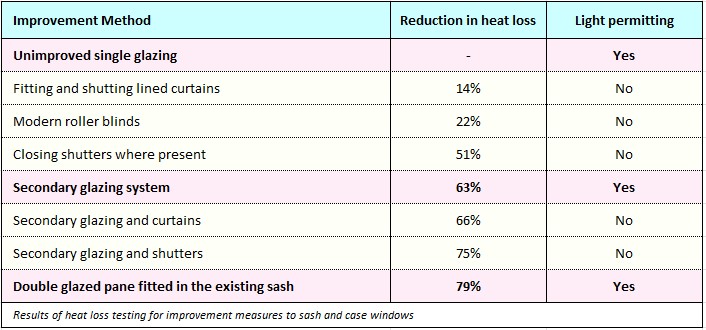Secondary Glazing gives Excellent Heat Retention
Secondary Glazing rivals Double Glazing for heat retention and U-values at a fraction of the cost
There are many properties with single glazed windows. These will typically have 3mm glass in lightweight frames, and are a significant source of heat loss. With energy costs high and rising, there is a need to improve insulation of windows to limit these costs and create a more comfortable living environment that uses less energy.
It can be difficult to measure and compare the efficiency of different window insulation methods. Most DIY products are fitted by the homeowner, who will not have access to the equipment needed to accurately measure resulting improvements. In any case, such installations do not take place in the “controlled conditions” you would find in a laboratory, so cannot be used as anything more than a rough guide as to effectiveness. If you search online, there are a lot of companies offering their products and making statements about how well they perform, but these claims can vary widely and are typically in support of their products, usually lacking evidence to support them or properly compare with the obvious alternatives.
However, there is independent research and evidence published by Historic Scotland, who arranged for the Centre for Research on Indoor Climate and Health in Glasgow to test a “typical” timber single paned sash window. This type of window is usually large, inefficient at retaining heat and common in listed or conservation areas where replacing existing windows may not be possible. The relevant information and analysis from the research report is summarised below, and the full report can be reached from this link: Fabric Improvements for Energy Efficiency in Traditional Buildings. There are many other interesting reports on the Historic Scotland site, with floor, wall, chimney and roof space improvements explored, as well as specific building case studies. These are aimed at meeting Government carbon emissions reduction targets by all available means hence their independence in relation to any specific company’s products.
Percentage reductions in heat loss
One way to compare window insulation methods is by proportions of heat lost. The report gave the following findings in the table below.
Note that Secondary Glazing was a very effective overall option, especially in combination with curtains, for example, although only when they are closed.

U-values for different window types
The U-value represents the ability of a structure to transfer heat under controlled conditions, and is used as a window industry standard. The lower the U-value, the better the insulation. It is expressed in W/m2k (watts per square metre-kelvin).
The U-values noted in the report are:
– 5.5 for the original unimproved single glazed sash window
– 1.7 for the window after secondary glazing
– 1.3 for retrofitted double glazing replacing the original glass panes
Other measures were tested, for example lined curtains had a U-value of 3.2.
The figures are relevant as they clearly indicate that secondary glazing can get close to replacement windows in heat efficiency. Given that the initial outlay on secondary glazing is generally so low in comparison to replacing the existing windows, this will payback on the investment significantly quicker – see our Costed Case Study page for more details.
One other point from the report (also addressed in the costed case study) was that on the original window, 72% of heat loss was via the glass, with only 28% as a result of draughts. In further testing, full draught proofing reduced air leakage by 86%, although this was not included in the U-value changes which focused only on the glass heat loss. However, even though draughts are a lesser part of the heat loss problem, the relatively low cost of draught excluders can still make it worthwhile.
Living with Secondary Glazing
Feedback from our customers is that once secondary glazing is installed, they are able to turn the heating down and leave it on for shorter periods. This is made possible by the higher heat retention.
To give an example of this, we conducted a trial in conjunction with a customer, monitoring temperature changes through a secondary glazed window over a 24 hour period. This used remote thermometers on the outside and inside of the property, as well as in the void behind the secondary glazing. The trial showed good results from the secondary glazing and is described in this separate case study.
Air Conditioning in Summer
In hotter weather (and sunnier climates than the UK), more properties are using air conditioning to stay cool. It is worth noting that the insulation provided by Secondary Glazing and good Draught Proofing will work in reverse, preventing cooler air from being lost via your windows, with the subsequent waste of energy. Tubeway have had a number of customers in South Africa, Australia, France and Spain, for example, who have taken advantage of this extra benefit.
